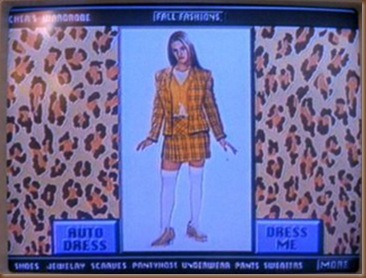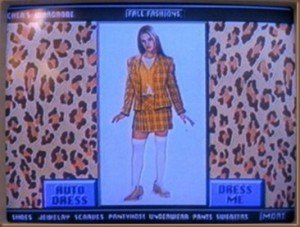Mirror, Mirror on the Wall: The Magic Mirror Gets a Makeover
One of my all-time favorite movie scenes is from Clueless (1995), the parody based on Jane Austen’s novel Emma. One of the opening scenes shows the lead character, Cher (Alicia Silverstone), getting ready for school and browsing through a closet the size of my apartment. And by browse, I mean she has two massive racks of clothing stacked on top of each other that move in opposite directions until the end of time. In addition to this, Cher’s computer (her personal computer – remember, this is 1995 we’re talking about, so home computer=dream) contains a database of each item of clothing in her closet and a program that determines whether certain pieces of clothing match*, through what I can only imagine is a brilliantly complex algorithm written by the guys who went on to invent Google. Beyond the technical savvy of Cher’s wardrobe, I was always captivated by the idea of virtually “trying on” an outfit. Fast-forward about fifteen years – is this idea still so outlandish? I’m starting to feel like living and breathing the age of all things digital has made the outlandish seem not only feasible, but practical.
I’ve found at least one product development team that agrees with me. The New York Times Co.’s research and development labs have created what can only be described as a magic mirror. The product is essentially a large mirror like you would find in your bathroom that is outfitted with motion-sensing technology, voice recognition software and a wealth of knowledge built up through New York Times APIs. Together, these technical features allow a user to communicate with the mirror (much as Snow White’s evil queen stepmother does, but about a million times cooler because the output message isn’t always “Thou, O Queen, art the fairest of all”).
Imagine flossing your teeth while perusing the New York Times headlines. Or shaving while studying the crossword puzzle. The capacity of this mirror goes far beyond the content served up by the New York Times, as it incorporates all our favorite personal management tools – calendars, lists, messaging capabilities, pop-up schedule reminders, and what would have been Cher’s all-time favorite activity if she grew up in the age of internet, online shopping. On that note, the team at the New York Times Co.’s R&D labs is currently expanding upon the magical mirror retail experience. Here’s a snippet of the video transcript that I link to below:
“This is fun because [the mirror will] find my face — and from my perspective, the tie lines up. It’ll attempt to match the colors to put on the tie. So, again, it’s all about context. And you can see previous outfits that I may have been wearing, and from there make recommendations about what I might like to try on next, etc.”
I imagine this product to be something like a giant iPad that serves the dual purpose of a mirror. Plus the Internet. Then integrates them all together to produce a tool that can do things like create an outfit that matches your skin tone or remind you to take your morning meds. Much like the digital gadgets we’ve grown attached to [literally] at the hip, we want full functionality – multiple tools in one gadget – and customization to fit out needs, and the magic mirror does all this and more.
While I’m far from convinced that this is actually necessary to living our everyday lives, I have no doubt that products like the magic mirror will become mainstream in no time, be it as a bathroom mirror, a coffee table, or a refrigerator panel. At the very least, those extra few minutes of reading the newspaper headlines could make us all a little less Clueless.
Watch a short demonstration of Retail and the Magic Mirror
Nieman Lab article on the Magic Mirror
*If your memory of 90’s films is a bit hazy, watch the Clueless trailer and skip ahead to minute 1:32 to catch a glimpse of Cher’s technically advanced wardrobe and personal computer program (and then watch the whole trailer to be transported back to the greatness that was 1995).



2 thoughts on “Mirror, Mirror on the Wall: The Magic Mirror Gets a Makeover”
Comments are closed.